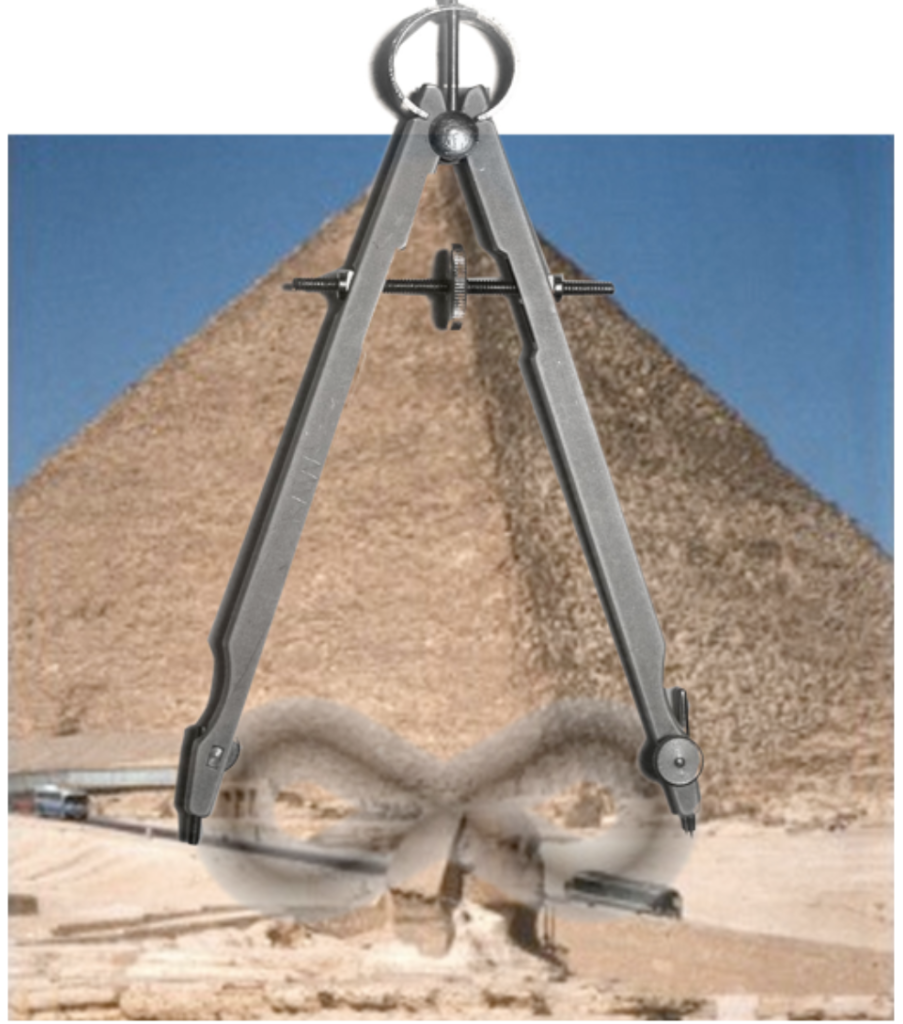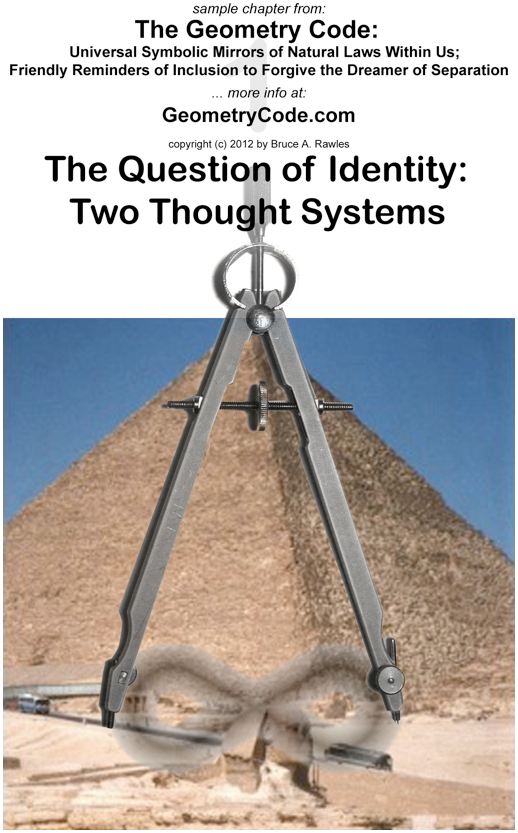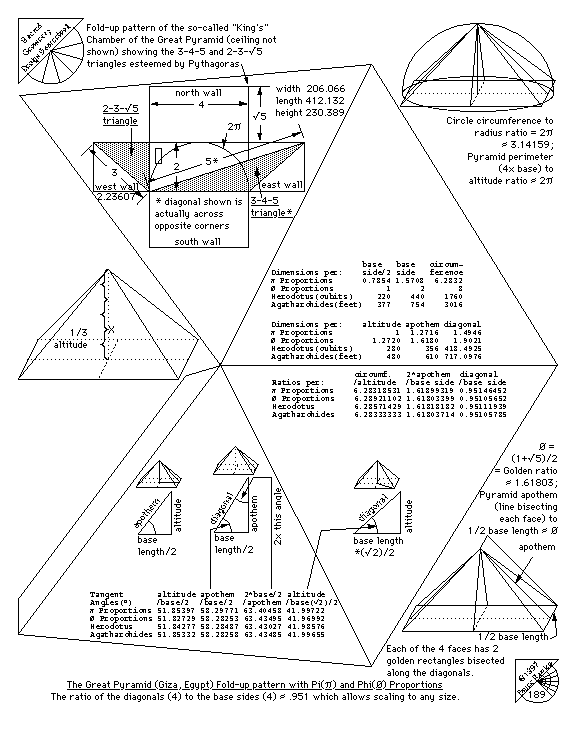
Search Results for: Great Pyramid
Digital dabbling with Dall-E
After several years of mixed results with Siri (on my iPhone and MacBook Pro) and cylindrical kitchen add-on Alexa, often amusing and sometimes rather useful, I think my current favorite “Jetson” technology still might be our humble shorter cybernetic cylinder, “Rosie” the Roomba – our household vacuuming robot weekly whisking an amazing amount of fur from feline friends in our home.
Out of curiosity, I recently have done some very preliminary explorations with 2 OpenAI artificial intelligence apps; ChatGPT – rather impressive for certain well-defined tasks – and Dall-E 2. Since the latter seems appropriate for the visual nature of geometric imagery, I gave it a few prompts and got the results below within a span of about 45 minutes. Most of that time was spent thinking up a geometric ideas and then reviewing (clicking on the smaller thumbnails to see the zoomed-in) results; the actual time that the application took to generate the images with about 10-20 seconds for each batch of 4 rendered thumbnails! At its present maturity, Dall-E seems to have some limited usefulness if mathematical precision is less important than artistic conceptual prototypes. What do you think? Fun to play with, of course! The text I typed is followed by the output for each experiment:
experiment 1:
golden glowing dodecahedron hovering above a shimmering sea of 144 smaller iridescent silvery icosahedra

experiment 2:
a fleet of 12 toroidal UFOs arranged in a circle beaming light to the apex of the Great Pyramid of Giza, Egypt with a rainbow gradient sky

experiment 3:
Mandelbrot set made of cedar sprigs in the style of M.C. Escher

experiment 4:
(Anthony James mirrored icosahedron variations by Dall-E; I used this image as input)

experiment 5:
Impressionist painting in the style of Vincent Van Gogh of CERN hardware

experiment 6:
A photo of the Eiffel Tower scaled to fit in the middle of Stonehenge with glowing orbs atop each megalith in the style of Salvador Dali

… with 4 more variations requested:

experiment 7:
7 purple Flower of Life disks wrapped around a silver cone reflected in a parabolic mirror by Rene Magritte (and 2 more sets of 4 variations)



experiment 8:
a photorealistic image of Dorothy from the Wizard of Oz holding hands with Alice in Wonderland standing in front of the Great Pyramid at Giza, Egypt.
(If you look closely at the faces, they look rather wonky at best, but zoomed out not too bad… Of course the 2nd, 3rd and 4th images used the 2nd “Kephren” pyramid which still has the capstone casing and not the Great Pyramid, but this is a learning technology, right. I wonder if the next time someone asks for a similar image, Dall-E will incorporate my comments and stick to just the Great Pyramid?)

The Geometry Code (Kindle edition) turns 10 today!
On this day in 2012 – a few months after introducing the print version, I made the Kindle version of my second book available: The Geometry Code: Universal Symbolic Mirrors of Natural Laws Within Us; Friendly Reminders of Inclusion to Forgive the Dreamer of Separation. I’ve appreciated all the support and encouragement during the past decade for this work, intended to be a bridge between two primary interests: the principle of interconnectedness reflected in geometric archetypes … and pure non-dual metaphysics.

The cover art and the opening graphics for the last 7 chapters in the book are symbolic interpretations of the 7 Hermetic Laws – covered in detail on this website.
However, I just realized that I never gave very many details on the first geometric image used in the book, so here are a few. The image below depicts a geometer’s compass spanning an infinity symbol – to represent ideas that are “all-encompassing” – and the Great Pyramid of Giza, Egypt (the last remaining of the seven wonders of the ancient world) with the Great Sphinx in the foreground. There is abundant fascinating geometry in both the exterior and interior of the Great Pyramid including the phi and pi proportions, squaring the circle, many terrestrial proportions, etc. which are covered in various talks and essays on this website spanning several decades.
The Pyramid’s foundation idealizes the square, connecting the compass (vertical axis) and square (horizontal plane of materiality.) The four sides of the pyramid and the overall shape of the compass are triangular, signifying the reconciliation of polarities, meeting in the capstone atop the pyramid and the apex of the compass where both vision and inspired guidance are possible through the exalted perspective that sees all as equal.
Here is the foreward to the book by Gary Renard:
I met Bruce Rawles in Medford, Oregon in 2008 and again in 2009 and 2010 in Ashland, Oregon when he and Ed Karlovich hosted and promoted seminars I did there. During one of the car rides to the airport, he mentioned a book that he was working on that sounded unique and original. I was curious as to how he would incorporate the diverse disciplines of sacred geometry (which he has studied extensively), Hermetic philosophy with its unchanging laws of nature, and the non-dual metaphysics that is the essence of my life work, best known to many by the spiritual masterpiece, A Course In Miracles (ACIM).
He was quick to point out that it’s easy to get distracted or diverted by external indicators like geometric symbols and get bogged down in specifics or interpretations that lead away from wholeness and toward the problematic belief in the concept we call separation or ego. At best, symbols can be mirrors or reflections within a dualistic world that attest to principles guiding our minds back to an awareness that has no opposite, an experience of love that transcends anything that can be conveyed by words or symbols of any kind. These symbols, seen from that view that embraces oneness, reflect a healed mind, but are never the cause of it.
He also recognized that the very ‘universal’ laws that can seem to keep us stuck in the dream (to our detriment) can also be reinterpreted for everyone’s benefit by the inner teacher of kindness that ACIM refers to as Holy Spirit and my teachers abbreviate metaphorically as ‘J’. We can learn to trust this inner teacher and use every bit of feedback as cues or reminders to practice, practice, practice the spiritual art of quantum forgiveness, which sees our ‘problems’ as causeless, and therefore completely benign and forgivable.
Having acknowledged these two caveats, he has done a remarkable job of sharing how – by developing trust in the inner Inclusive Guide we all have in common – we can include the symbolic contents of our unconscious mind in very familiar forms, such as geometric ones, as feedback devices or memory jog aids to deepen our trust in our inner teacher. For example, Bruce points out how egos use circles dualistically to exclude and banish ‘others’ to the outer regions (and the equally unhelpful ‘special love’ for those ‘within the circle’), but can just as easily be reinterpreted to be infinitely large, including All as One.
Similarly, with his explanations of seven laws of nature, it becomes obvious that these unchanging rules (starting with the fact that the universe exists only in mind) can be directed by either the 100% sane thought system or the 100% insane thought system that we all share. The choice is up to us, moment by moment. Without the specific people and events of our lives – including the exemplified laws and forms we encounter – our unconscious guilt would never be revealed, released, and healed.
Countless other examples demonstrate the importance of forgiving the dreamer of separation; this work is a fun and useful addition to the list of ACIM studies books. Bruce and I share the kinship of all (not just those one would call students) learning to practice forgiveness, gently awakening our dreaming minds to Love that is beyond any words or symbols. Enjoy, and awaken.
– Gary R. Renard, the best selling author of The Disappearance of the Universe
Reflections on the Sacred: Geometry, Mind, Non-duality
Over the years, I’ve been asked by many: “What Makes Sacred Geometry sacred?” to which I usually respond with something like this: Either everything is sacred … or nothing is sacred. While that terse response may seem to be evading the question, I’ve realized more and more deeply that it’s true, and if we gradually (with help from the Inner Inspiration we all can employ) shift our perception from the ephemeral to the eternal then our view of everyone and everything becomes kinder, more compassionate, tolerant and forgiving of the minutiae of the fleeting phantasms of form and the cosmically temporary. If truth doesn’t change, our task must be to seek and find what is true and cannot change; the laws of mathematics and geometry seem worthy candidates for possible means of finding the unalterably true. However, for something to be unequivocally true, it must apply to everyone and everything. The discipline of the scientific mind requires that we keep looking if we find exceptions to our postulates and theorems and persist until we find the safety, security, and serenity of what can never change. William Shakespeare penned lovely prose about the ideal of looking ever inward to the mind for what doesn’t alter or change when it (the mind) finds the alterable:
Sonnet 116: Let me not to the marriage of true minds
BY WILLIAM SHAKESPEARE
Let me not to the marriage of true minds
Admit impediments. Love is not love
Which alters when it alteration finds,
Or bends with the remover to remove.
O no! it is an ever-fixed mark
That looks on tempests and is never shaken;
It is the star to every wand’ring bark,
Whose worth’s unknown, although his height be taken.
Love’s not Time’s fool, though rosy lips and cheeks
Within his bending sickle’s compass come;
Love alters not with his brief hours and weeks,
But bears it out even to the edge of doom.
If this be error and upon me prov’d,
I never writ, nor no man ever lov’d.
Seeking what is true for all, we realize we are all in the “same boat” either expressing kindness or in one way or another asking for it. Seen from this perspective, our true kinship – our real relationship – to everyone and everything merits kindness in response to expressions or requests for the same. That seems like a very serviceable and practical definition of sacredness – generalized to encompass all, sacredness reflects the perfection beyond the forms our senses and the mind’s machinery of interpretation seem to establish as real. We rarely question the vast number of assumptions we make every second about the world that seems vulgar and profane or at the very least disappointing in its impermanence.
A few dictionary definitions of the word sacred (most closely aligned with how I think of the word) are “revered, inviolable, inviolate, unimpeachable, invulnerable, untouchable, inalienable, protected, defended, secure, safe, and unthreatened.” These adjectives would suggest that nothing in this material world – where every form that appears eventually disappears – would qualify for sacredness; no exemption for the changed, changing, and changeable from decay, dissolution, and death. Yet while the laws of physics (particularly the Second Law of Thermodynamics) would suggest that nothing in spacetime is forever, we certainly can use our experiences in the world of space and time to guide us (even if largely as counterexamples) to find what is endless.
Our experience of sacredness – which I would equate with the purely innocent eternal nature of our being and all that remains in mind after we have completely forgiven ourselves and everyone for everything – depends completely on the thought system with which one views everything! If we look for what unites us, what is intrinsically the same for all – regardless of all the polarizing temporary attributes that seem to define our ephemeral personas and certainly our bodies – we find the sacred, innocent undifferentiated awareness from which all creation derives and to which we all belong.
What prompted this metaphysical musing? My computer calendar showed me that a decade ago today, I published my second book in print form, followed by a Kindle edition a few months later. I was also reflecting fondly on some related anniversaries:
- 10 years ago today, The Geometry Code: Universal Symbolic Mirrors of Natural Laws Within Us; Friendly Reminders of Inclusion to Forgive the Dreamer of Separation became available in print
- 15 years ago (2007), I “rediscovered” the pure non-dual metaphysics of A Course In Miracles by way of Gary Renard‘s first book: The Disappearance of the Universe: Straight Talk about Illusions, Past Lives, Religion, Sex, Politics, and the Miracles of Forgiveness and shortly thereafter started ACIMblog.com and started a weekly study group (now online)
- 25 years ago (1997) I launched my first book, Sacred Geometry Design Sourcebook – Universal Dimensional Patterns
- 30 years ago (1992), having “rediscovered” what has become known as sacred geometry via fellow mystical explorer and contemporary, Gregg Braden at a lecture in my mother’s living room in Livermore, California a year before – we (my now wife, Nancy, and I) accompanied Gregg (21 of us) to Egypt to explore the Great Pyramid of Giza and numerous sites up and down the Nile River
- 50 years ago (1972) I graduated from Livermore High School
Thanks to all of you for many decades of support, collaboration, and shared enthusiasm for finding what is true! Here are some excerpts from the June 2012 bulletin that provide details about my second book, which combined interests in both sacred geometry and non-dual metaphysics. The book “The Geometry Code: Universal Symbolic Mirrors of Natural Laws Within Us; Friendly Reminders of Inclusion to Forgive the Dreamer of Separation became available 10 years ago today: on June 5, 2012.
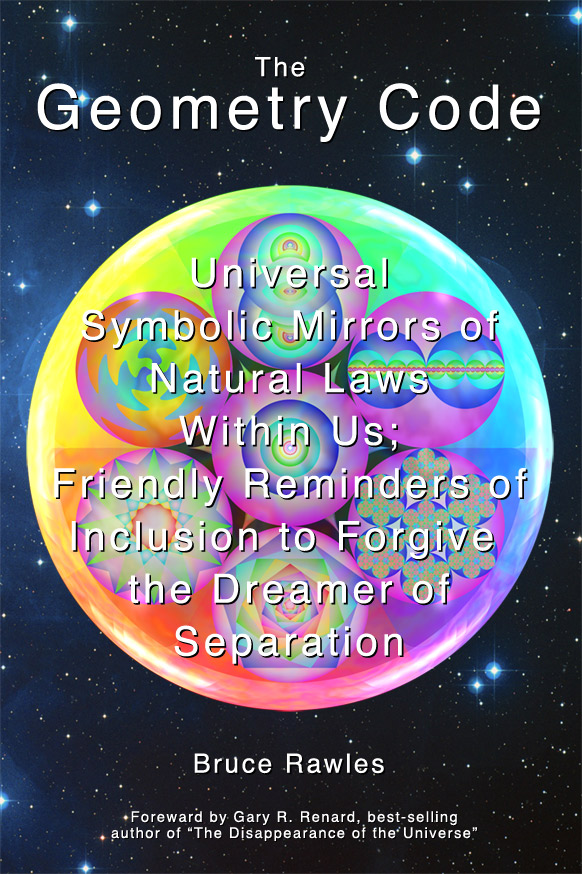
About the book: The Geometry Code
While I was completing work on Sacred Geometry Design Sourcebook, (completed in 1997), I was already working on another book, which was ready on June 5th, 2012. Rather than reinvent the wheel, I think the Preface I wrote explains how the book came about and gives a good “big picture” of what it is about. I’ve uploaded the Table of Contents, Endorsements from friends and colleagues, Acknowledgments, a sample chapter, and more.
Geometric Inspiration and Education
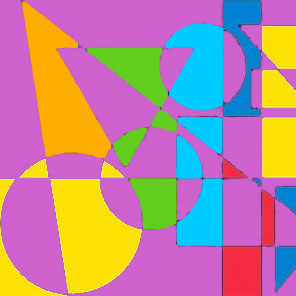 Reflecting on the growth – explosion, really – of information available to us online compared to what we had access to just a few decades ago, I recalled that in the early 1970s when I was an undergraduate electrical engineering student at UC Davis, California, I used the card catalog in a long row of tidy wooden cabinets at the Shields Library – a building which covers an entire block of the campus – to look up everything I could find (at that time) on the Golden Ratio, Golden Number, Golden Section, Divine Proportion, Phi (ø) or Tau (τ) Proportion, Sacred Cut, Extreme and Mean Ratio, etc. and other synonyms for the ubiquitous (1 + √5)/2 ≈ 1.6180339887… value. This fascination was my response to a gift of two books – both with references to the golden ratio – from my mother who indirectly introduced me to this enthralling subject which later was popularized with the term “sacred geometry”:
Reflecting on the growth – explosion, really – of information available to us online compared to what we had access to just a few decades ago, I recalled that in the early 1970s when I was an undergraduate electrical engineering student at UC Davis, California, I used the card catalog in a long row of tidy wooden cabinets at the Shields Library – a building which covers an entire block of the campus – to look up everything I could find (at that time) on the Golden Ratio, Golden Number, Golden Section, Divine Proportion, Phi (ø) or Tau (τ) Proportion, Sacred Cut, Extreme and Mean Ratio, etc. and other synonyms for the ubiquitous (1 + √5)/2 ≈ 1.6180339887… value. This fascination was my response to a gift of two books – both with references to the golden ratio – from my mother who indirectly introduced me to this enthralling subject which later was popularized with the term “sacred geometry”:
- Secrets of the Great Pyramid by Peter Tompkins
- This Living Earth by David Cavagnaro
I found a few dozen books that led to other books and on and on into the mystical realms of the intersections of mathematics, ornamentation, art, music, architecture, history, and above all – mind. … But after checking out those books, I felt I had somewhat exhausted the more obvious references to this topic in this library. … Not anymore!
Fast forward a half-century; now googling Sacred Geometry, as of today (21 April 2022) we get a staggering 45 million results for this niche topic (including my evergreen minimalist GeometryCode Introduction to the subject now way past overdue for a revisit and update) and 481 million for the Golden Ratio!
The same curiosity still remains in my mind: What can be counted on that does NOT change? The laws of mathematics in general and geometry, in particular, seem relatively stable, fortunately, at least within the context of the Cartesian space-time paradigm. When I was in high school, I read Education and Ecstasy by George Leonard and I realized that to really dive deep and learn immersively, one needed to be motivated, inspired or at least have their curiosity seriously piqued or their assumptions about life challenged. Exploring some of the ideas that these readings opened up for me was enough!
Now there are a multitude of online offerings that can motivate young and old alike to explore esoteric topics like interconnectedness (e.g. quantum entanglement), geometric symbolism and synchronicities, and so much more. Another vital element that has a multiplying effect is FUN!
Here are a few quickly-found resources for educators and explorers in this realm (including teachers, home-schoolers) and philosophers of all stripes:
- A simple but engaging animation showing basic 2D geometries morphing from one to another:
Shapes – Learn 2D Geometric Shapes – The Kids’ Picture Show (Fun & Educational Learning Video) - 10 Geometric Art Explorations (Study measurement, area, fractions, and more!) … The graphic of color-filled intersections of simple 2D shapes on this page was adapted from the image below the “6. Frac-Geo-Bot” section on this page.
- … for about 23 million more links, try googling “geometric art science toys videos”
- or try these categories on the GeometryCode website: coloring books for adults, sacred geometry art, sacred geometry books, sacred geometry coloring books, sacred geometry toys … just for starters
Enjoy! :-)
